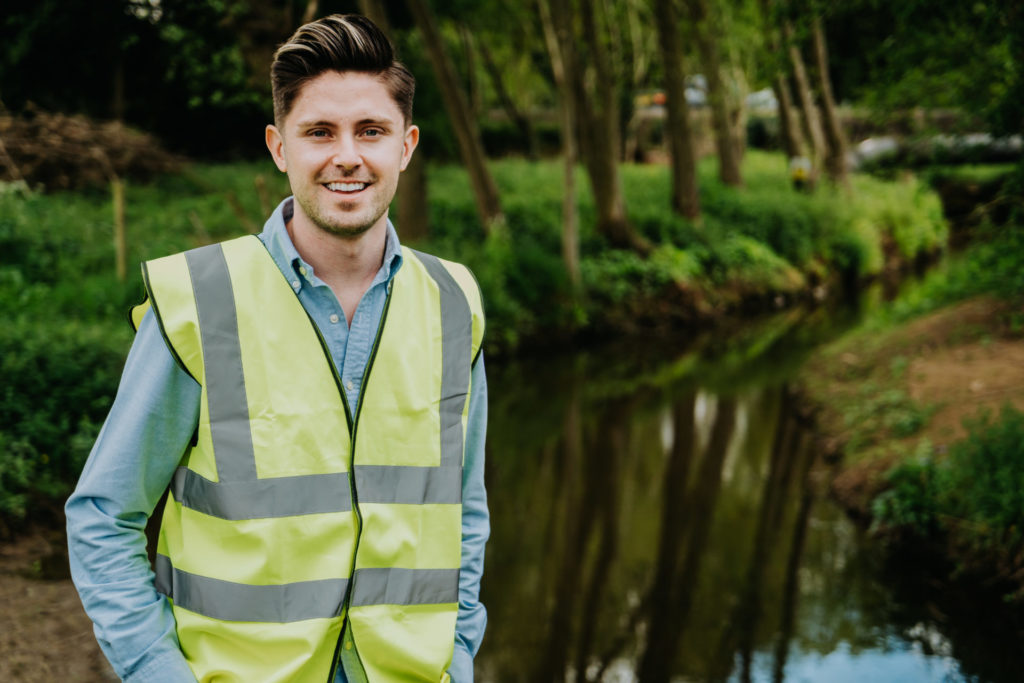The social, economic, and political opportunities of transitioning to a world powered by renewable energy is an exciting one, and one which must be embraced at all levels before it’s too late, says Simon Crowther
February 2020 in England was the wettest February since records began in 1910, and it was the fifth wettest winter on record. In the same year, internationally, there were record breaking heat waves, and even wildfires experienced in North America.
Unfortunately, these events are only going to become more frequent as global temperatures continue to rise at an alarming rate.
Globally, 2019 and 2020 ranked among the top three hottest years on record. Compared with the beginning of the last century, the mean global average temperature is now 1.1°C higher (IPPC, 2021). A warming climate can contribute to the intensity of heat waves by increasing the chances of very hot days and nights. Since the late 1960s, the number of record daily high temperatures measured each year has been increasing faster than record daily low temperatures. This shift is due to far fewer record daily low temperatures in recent decades.
A warming atmosphere is also associated with heavier precipitation events through increases in the air’s capacity to hold moisture. El Niño events off the west coast of South America favour drought in many tropical and subtropical land areas, while La Niña events promote wetter conditions in many places like the UK. These short-term and regional variations are expected to become more extreme and unpredictable in a warming climate.
Why is climate change happening?
There are many natural and anthropogenic (human-induced) factors that contribute to climate change. Climate change has always happened on Earth, which is clearly seen in the geological record of ice cores and carbon dating. In the past 650,000 years there have been several cycles of glacial advance and retreat, the last one ending about 11,700 years ago. Most of these climate changes are the result of small natural variations in the Earth’s orbit that change the amount of solar energy the planet receives.
However, the current warming trend is of great concern because it is the result of human activity. For millennia, atmospheric carbon dioxide levels had never risen above 300ppm (parts per million); but since burning fossil fuels and mass land use change began in the 1800s, this level has significantly jumped to 415ppm (NASA, 2022).
It is now believed the Earth has entered a new geological epoch known as the ‘Anthropocene’, where humans are now the main driving force behind Earth’s climate over natural phenomena.
Does climate change affect flooding?
Moisture content within the air is dependent on the temperature. For every 1 °C rise, the air can hold approximately 7% more water (IPCC, 2017). According to the UN Environment Programme (UNEP), higher temperatures result in more cloud formation from surface evaporation. More clouds can hold more rain which correlates to a higher frequency, duration, and intensity of precipitation and storm events.
‘It’s just basic physics. Big storms with large amounts of rainfall are limited by the amount of water vapour in the atmosphere. As we increase the moisture in the atmosphere, we increase the amount of rainfall in these extreme precipitation events’, says Kenneth Kunkel, an atmospheric scientist at North Carolina State University.
But the precipitation story turns out to be more complicated than that. A thunderstorm is essentially a tower of upward-moving winds that feed themselves by sucking in warm air from nearby. When the air rises high enough, it cools and condenses into rain. Storms can generate their own weather, such as creating cold pools of air near the ground that trigger more convection. Climate change can amplify these effects, causing updrafts to grow stronger and wider, pulling in more warm air from surrounding regions which leads to more rain.
How will climate change continue to have an impact? Case study: The UK
The UK is already experiencing the effects of climate change in the form of extreme weather, with both heatwaves and an increasing flood risk.
Flooding: The UK is facing frequent record-breaking flooding, often due to more intense bursts of rainfall.These include extreme weather events known as atmospheric rivers, or air currents heavy with water from the tropics. Experts predict these will intensify, bringing as much as 50 percent more heavy rain to the UK by the end of this century. Of course, heavier rainfall does not automatically lead to floods, but it significantly increases the potential for them.
According to the most recent climate change Risk Assessment (CCRA) report, an estimated 1.8 million people are living in areas of the UK that are at significant risk of coastal, surface or river flooding. The population of people living in such areas is projected to rise to 2.6 million by the 2050s under a 2°C scenario rise.
Along the English Channel coast, the sea level has already risen by about 12cm in the last 100 years, and with the warming over the next few decades, a further 11-16cm of sea level rise is expected by 2040. Rising sea levels combined with more intense storms is increasing the number of inland areas prone to tidal flooding. As the relative sea level increases, it no longer takes a strong storm to cause coastal flooding; flooding now occurs with high tides in many locations due to climate-related sea level rise.
Heatwaves: In the UK, heatwaves are considered extreme when temperatures exceed 30 °C. In July 2019 a record high temperature of 38.7 °C was recorded in Cambridgeshire, while the longest stretch of extreme heatwave temperatures was recorded the following year.
Not only do extreme heatwaves cause spikes in toxic air pollution, but they also make areas more vulnerable to flooding. When intense rainfall occurs after a prolonged heatwave, water struggles to infiltrate through the soil quickly enough due to the soil being hard and dry. The effect is extreme precipitation surface run off, and the local drainage networks becoming overwhelmed. Flash floods from prolonged dry conditions are becoming increasingly common in the UK
Are there any international efforts to try and combat these effects of climate change?
COP26: Described as ‘An event believed to be the world’s last best chance to get run away Climate change under control’, COP26 was attended by world Governments in November 2021, with the aims of:
- Securing a global net zero by mid-century; and
- Keeping global temperature rise within 1.5 °C;
At the end of COP26, 151 countries submitted new climate plans to cut their emissions by 2030 through various means.
More than 100 countries signed a pledge to end world deforestation by 2030. While over 40 nations pledged to phase out coal use within the 2030’s (2040’s for poorer nations), including big coal dependent nations like Vietnam and Chile. However, some of the largest coal producing nations like China and India, did not sign up to the pledge.
Global emissions need to be halved by the end of this decade to limit temperature rise to 1.5 °C. However, as it stands the United Nations calculates these plans will still cause a 2.5 °C increase by the end of the century. This is much better than the 4 °C trajectory the world was on before the 2015 Paris Agreement, but still too much.
Though, some big emitters 2030 targets from China, Brazil and Russia don’t offer pathways to achieve their emission cut targets…
To fix this problem, the COP26 agreement calls on all countries to ‘revisit and strengthen’ their 2030 targets by the end of 2022. While also asking countries to submit long term strategies to transition to net zero by 2050.
So, what can we expect for the future?
Flooding gives valuable insight to the growing threat of a changing climate and is a reminder of our vulnerability. Flood damage currently costs the UK alone around £1.3 billion each year and is projected to increase.
But it’s not just the physical and economic damage which is of concern. Research has found that people who experience flooding are 50% more likely to suffer from mental health problems, including depression and anxiety.
It is therefore essential a holistic approach in how we live and respond to the effects of climate change like flooding is implemented, such as making properties more resilient to flooding within their design and construction, as well as greater public awareness.
The COP26 agreement has given hope that the effects of climate change can be reduced. The social, economic, and political opportunities of transitioning to a world powered by renewable energy is an exciting one, and one which must be embraced at all levels before it’s too late.

Simon Crowther is CEO of FPS Group founded in 2021, which comprises of Flood Protection Solutions Ltd and FPS Environmental Ltd.
He is an award-winning Civil Engineer and Chartered Water & Environmental Manager, recognised by Forbes Magazine in its top ‘30 Under 30’ Europe list for his work in the industry.
Simon founded his first company, Flood Protection Solutions Ltd aged just 18, whilst still at university. Within five years the company had a turnover of two-million pounds, with clients ranging from homeowners through to heavy industry, including the likes of the NHS, Environment Agency, and Thames Water.
Simon’s passion for minimising flood risk derives from the traumatic experience of his family home being flooded in 2007.
The flood risk sector is an incredibly difficult and challenging industry, with investment sporadic and often a ‘knee-jerk’ reaction to flood events. To ensure a successful future for the business, Simon invested in technology and launched an e-commerce site in 2017, making the best equipment readily available to all. This site is now on track to reach a turnover of one-million pounds during 2021.
Simon has recently launched ‘FPS Environmental Ltd’ which will focus on flood risk and environmental consulting. This launch is driven by Simon’s desire to provide the highest-level of advice to customers, ensuring maximum flood risk reduction. Within three years, the turnover is expected to reach more than £2m GBP; placing the group’s turnover in excess of five million.
Despite his successes at such a young age, Simon remains grounded and is fully focused on both raising awareness of flood risk, and subsequently helping to reduce it. He is regularly featured by media outlets and recently featured on a Channel 4 documentary investigating the likely impact of climate change on the UK – A Summer of Wild Weather.



